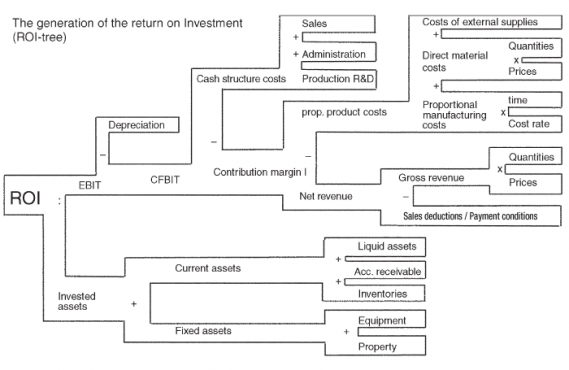Difference between revisions of "Ratio systems"
From ControllingWiki
Achtung. Sie nutzen eine nicht mehr unterstützte Version des Internet Explorer. Es kann zu Darstellungsfehlern kommen. Bitte ziehen Sie einen Wechsel zu einer neueren Version des Internet Explorer in Erwägung oder wechseln Sie zu einer freien Alternative wie Firefox.| [unchecked revision] | [unchecked revision] |
| Line 3: | Line 3: | ||
Ratio systems are (mathematically or logically connected) combinations of ratios (absolute or relative figures with special significance). Ratios are derived from planned values or actual data and serve as a measurement to show the cause and effect of changes in operations. Under the entry ”objective” we have a ratio system structure, which can be used to compare budgeted and actual figures. | Ratio systems are (mathematically or logically connected) combinations of ratios (absolute or relative figures with special significance). Ratios are derived from planned values or actual data and serve as a measurement to show the cause and effect of changes in operations. Under the entry ”objective” we have a ratio system structure, which can be used to compare budgeted and actual figures. | ||
| − | The [[Return on Investment ROI ROI]]-tree (see diagram) shows the return on investment (more precisely: return on operating assets) and the factors that influence it in an inter-linked pattern of accounting. | + | The [[Return on Investment ROI|ROI]]-tree (see diagram) shows the return on investment (more precisely: return on operating assets) and the factors that influence it in an inter-linked pattern of accounting. |
[[Image:Ratio systems.png|x370px|]] | [[Image:Ratio systems.png|x370px|]] | ||
Revision as of 08:53, 1 September 2010
IGC-DEFINITION (abbreviated)
Ratio systems
Ratio systems are (mathematically or logically connected) combinations of ratios (absolute or relative figures with special significance). Ratios are derived from planned values or actual data and serve as a measurement to show the cause and effect of changes in operations. Under the entry ”objective” we have a ratio system structure, which can be used to compare budgeted and actual figures.
The ROI-tree (see diagram) shows the return on investment (more precisely: return on operating assets) and the factors that influence it in an inter-linked pattern of accounting.
from: IGC-Controller-Wörterbuch, International Group of Controlling (Hrsg.)

